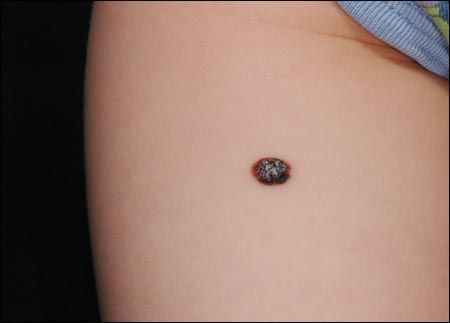Would you biopsy the pigmented lesion on this young boy’s thigh?
This pigmented lesion has developed over the past 12 months on the posterior aspect of a 3-year-old boy's thigh. The lesion measures 5 mm and exhibits a dark black nodular center with a light brown pigmented periphery. The lesion is asymptomatic, and the child is well.

Case:
This pigmented lesion has developed over the past 12 months on the posterior aspect of a 3-year-old boy's thigh. The lesion measures 5 mm and exhibits a dark black nodular center with a light brown pigmented periphery. The lesion is asymptomatic, and the child is well.
Would you biopsy this lesion to rule out melanoma or is this child too young for this malignancy?
Answer on Next Page
Biopsy is recommended; melanoma is rare in young children but can occur.

In my opinion, this lesion requires excisional biopsy. The morphology of the lesion and age of the child suggest that Spitz nevus is the most probable diagnosis; however, I could not confidently rule out melanoma as a possibility. Spitz nevi are usually between 5 and 10 mm in diameter; about half are present on the head and neck, with the remainder evenly distributed on the trunk and extremities. These nevi are generally dome-shaped and pink but may be brown or black in unusual circumstances.
This clinical presentation supports the original concept of the Spitz nevus as a "benign juvenile melanoma." The fact that the histopathology may also resemble a melanoma further supports this older concept. Today, a Spitz nevus is thought of as a spindle or epitheliod nevus, reflecting the predominantly benign pathology. Atypical presentations of Spitz nevi often require expert opinion in order to avoid the mistaken diagnosis of melanoma.
Melanomas do occur in childhood, although rarely. It is estimated that about 2% of all melanomas occur in persons younger than 20 years and 0.3% in children younger than 14 years. The risk factors, morphological features, and prognosis of melanoma in children are similar to those in adults.
This lesion was completely excised. The dermatopathologist diagnosed the lesion as a compound Spitz nevus. The pathology revealed rare mitotic figures in the upper aspects of the lesion; however, this finding was thought to be acceptable in a 3-year-old child.
Recognize & Refer: Hemangiomas in pediatrics
July 17th 2019Contemporary Pediatrics sits down exclusively with Sheila Fallon Friedlander, MD, a professor dermatology and pediatrics, to discuss the one key condition for which she believes community pediatricians should be especially aware-hemangiomas.